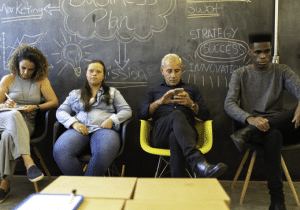USING HIRING BIASES TO YOUR ADVANTAGE
Understand these biases and win!
You will not find this topic in many job search books, but it is crucial to your success in the interview.
Interviewers deploy numerous biases when they meet you for the first time. Biases are preconceived judgments about a candidate that impact how the interviewer sees you upon meeting you (both positively and negatively), thereby making the interview less objective.
Organizational psychologists understand the limited predictive values of job interviews due to interview bias and why good interviews include additional assessments (multiple data points) to increase the predictive accuracy of the hiring process.
Biases also tend to exaggerate the differences between individuals that do not belong to the same social group, while amplifying the similarities of those from similar social groups.
Research has shown that individuals with a greater tendency for control rely more on biases. We rely on our biases more when we are under stress. A job interview is just as stressful for the interviewer as the candidate. Untrained interviewers often rely on biases to make the final hire/do not hire decision.
Psychologists describe biases as heuristics (mental shortcuts to help people make rapid decisions). Categorizing people helps us navigate our social interactions with others more efficiently. The key to a successful interview is understanding them, minimizing those you can control, and using them to your advantage.
Employers are taught to use multiple interviewers with diverse backgrounds to minimize biases. Including others can help reduce or balance selection biases. Each interviewer is asked to rate the candidate after each question and not discuss the ratings until the end of the interview.
Job seekers need to understand each of the following biases and attempt to minimize ways that could trigger the bias. They also understand that negative first impressions tend to be weighted more than positive and are more difficult to change during the interview. The saying, “you only get one chance to make a first impression,” is very true in hiring. Dress the part and act confidently when answering questions to improve your chances of getting the job offer.
FIRST IMPRESSION BIAS
First impression bias is defined as making a decision based on an early experience with the candidate. If the first impression is very positive, chances are the final decision will also be positive, unless the candidate does or says something that is not in line with the interviewer’s point of view (See unconscious bias).
The first impression that an interviewer makes is hard to reverse unless you outperform the competition during the interview (better stories). First impression bias leads to numerous hiring mistakes where high-performing candidates with weak presentation skills get passed over for candidates that are better at making a case for their candidacy.
TIP: Look the part (dress professionally even if employees dress more casually). Practice answering interview questions out loud until you are polished. Make eye contact and smile (if it is appropriate for the culture), know about the company, show enthusiasm for the job, and come to the interviewer prepared and put on your best performance.
Trained interviewers often conduct a phone interview as the first interview to minimize numerous biases including First impression, Unconscious, and Confirmation biases. Stand up during a phone interview to sound more confident.
Video interviews are becoming more popular. They tend to be difficult for untrained candidates who do not know how they come across to the interviewer. Candidates tend to look at the eyes of the interviewer on the screen instead of the camera when speaking (or down to their notes when trying to make key points).
The interviewer sees that the candidate is not making eye contact since they are not looking into the camera and may perceive the candidate as not being confident or honest.
Practice looking directly at the camera, not the person’s eyes on the screen (more difficult than it sounds—so practice).
Place a picture of the person (a family member or best friend) just above the camera and look at it to appear as if you are making direct eye contact.
This tip has helped many weaker candidates beat the competition. Move two to three feet away from the camera to minimize the lack of eye contact effect.
Another suggestion is to move the person’s image directly under the camera and look at it when speaking.
SIMILAR-TO-ME
Favoring a candidate who has a similar mindset, rate or speech, mannerism, and background.
TIP: Research the interviewer on LinkedIn. Look for comments they made to stories they read. Learn what people and organizations they follow and see if you share any of them.
Read their information posted on their Facebook page. Click on “About” (Contact and Basic Info section). Mention something you share with the person (perhaps a love of a sport, hobby, favorite travel destination, favorite book, favorite quote, same college or university, high school, hometown, etc.) when you are asked to “Tell me a little about yourself.” Try to mirror their rate of speech to get additional points.
NON-VERBAL BIAS
Non-verbal bias occurs when interviewers look for clues based on body language rather than skills. This bias can negatively affect candidates from cultures that do not share the same body language preferences as the interviewer’s culture.
A person may come from a culture where they are taught not to make eye contact when speaking with a superior is a sign of respect. Lack of eye contact could be viewed negatively when you are interviewed by a person from a culture where eye contact is a sign of respect and integrity. Autistic job candidates may struggle with social cues and avoid eye contact.
TIP: If you are an international job candidate (or the interviewer is from a different country or culture), ask for the name of the individual(s) that will be interviewing you. Look them up on LinkedIn to get a feel for their background, views, and achievements. Read any postings they authored to get a feel for what they value and believe.
Look at the people and groups they follow to get a sense of what they believe and value. If you are asked about a favorite book/author, mention a book by one of the people they follow and how the book impacted you (huge points).
Adjust your body language to make the best non-verbal impression possible (sit up straight, lean in slightly to show interest). Your body language and mannerism should conform to the country/culture of the person with whom you will be interviewing. In many countries, it is a sign of disrespect if you cross your legs and show the sole of your shoes. Practice keeping both feet on the floor. You do not want to lose points by triggering the interviewer’s non-verbal bias.
UNCONSCIOUS BIAS
Unconscious biases are mental shortcuts to protect us by making rapid decisions in situations. Unconscious bias (also referred to as Implicit bias) includes perceptions and social stereotypes that people unconsciously attribute to individuals and groups that impact the way they engage with the person or group.
Interviewers who conduct an interview without a list of job-specific questions (unstructured job interview) tend to rely more on an unconscious bias (gut instinct) and may make discriminatory decisions based on preconceived ideas or thoughts. They may also scrutinize the candidate in greater detail.
TIP: Understand that unconscious bias is not intentional. Avoid doing anything that may trigger a negative impression at the beginning of the interview when unconscious bias is at the highest.
Do the following to minimize unconscious bias:
- Dress the part (professionally, even on a video call).
- Leave your mobile phone in the car or turn it off to avoid looking at it.
- Smile and act confident (confidence = competence!).
- Make eye contact (if the culture values this).
- Show your enthusiasm for the job and the company.
- Know at least three things about the company.
- Know at least five duties listed in the job description.
- Be prepared to mention something the company just announced (research).
AFFINITY BIAS
Affinity bias is where the interviewer is looking for similarities between themselves and the candidate. People tend to gravitate towards people who appear, act, and hold values that are similar to theirs.
Tip: Get the names of the person with whom you will be interviewing and conduct a search for them on LinkedIn and Facebook.
On LinkedIn, you can uncover their work background, where they went to college, what people and groups they follow, and see if you share any of these in your background.
Use Facebook to get a social sense of the type of person they are and activities they enjoy doing such as hiking, biking, golf, tennis. Mention any of these that you share with them to establish a connection.
CONFIRMATION BIAS
Confirmation bias is the tendency to favor information that more closely aligns with what we know and believe. We use confirmation bias when holding strong opinions on what we believe, for example, gun control, political views, causes of global warming, etc.
We tend to read news stories that reaffirm our beliefs and avoid those that do not. Interviewers demonstrate confirmation bias by resisting any information that does not favor what they know and believe, which often results in faulty hiring decisions.
Tip: When you get the interview invitation, ask for the name and title of the people with whom you will be interviewing. Look them up on LinkedIn to get insight into their background, what people and groups they follow. Avoid answers that would contradict their point of view.
STEREOTYPE BIAS
Stereotype bias is like Unconscious bias. The interviewer assumes you have certain traits because you are part of a certain race, gender, religion, age, or appearance. If the job requires you to lift 50 lbs. on a repetitive basis, an interviewer may assess female and older candidates negatively.
Interviewers can display their stereotyping by deciding to speak louder and more slowly to older job candidates (assuming an older candidate may have hearing loss and process information slower).
Tip: Minimize the interviewer’s stereotype bias by looking at the job requirements that might impact a stereotype (lifting, understanding technology, ageism, etc.). Be sure to mention that you understand the job requirements and have an example ready that clearly demonstrates you meet that requirement when asked to speak on a specific topic (ability to work in a multi-cultural environment, report to a younger boss, work effectively with the latest technology, outperform a younger worker, etc.).
Read the job requirements closely. You may decide that key job duties are not of interest to you or align with your values and beliefs and look for jobs that more closely align with what you enjoy doing.
CULTURAL NOISE
This bias is focused on telling the interviewer what you think they want to hear instead of being your authentic self. The interviewer with this bias will likely ask hypothetical questions and have a hard time distinguishing your socially acceptable answer from your genuine belief.
Tip: Look at the job description closely and identify job requirements you may not enjoy doing. For example, if the job states, “the ideal candidate will make outbound calls and engage customers in learning about our products or services.” You should have specific examples ready where you have enjoyed meeting and speaking with strangers.
If you know you have very little interest in making sales calls, you may want to look for a job that does not have this requirement rather than attempt to convince the prospective employer that you enjoy making sales calls to strangers just to land the job. Remember, the job should also meet your requirements and be fulfilling.
GENDER BIAS
Numerous studies confirm that when equally qualified male and female candidates are being considered for a job, men tend to prevail. The National Bureau of Economic Research conducted a study in 2019 and concluded that when men and women had the same skills tested and asked to rate their performance, men rated their performance 33% higher.
Women were far more likely to sell themselves short when commenting on their performance. Women tended to start by offering an apology for a failure, whereas men tend to brush off the failure and focus on what they learned and how it helped them grow.
Tip: Valerie Alexander states that competence and confidence are perceived as the same trait. If you are highly competent and behave without confidence, you will be perceived as incompetent.
Videotape your practice interview. Are your answers rich in detail and do you come across as confident? Practice until you can answer each question with confidence! Never apologize for mistakes. View mistakes as outcomes. Admit the mistake and mention how it was a pivotal lesson for helping you grow as a person.
RECENCY BIAS
Our minds are hardwired to remember details about the information we receive most recently. Notice if the interviewer is taking notes or scoring you after each question. Untrained interviewers rarely take notes, which makes it extremely difficult to accurately compare the candidates they interview.
The problem gets worse if the interviewer does not use a structured interview (does not ask each candidate the same set of job-relevant interview questions). They are thinking of their next question instead of listening to your answer.
TIP: To win, you will need to provide rich, detailed stories when answering their questions (unless the hypothetical interview question does not present the opportunity for a specific answer. Example: How many stoplights are there in New York City? Answer the hypothetical question by applying as much logic as possible when answering.
When you get an interview invitation, ask what time slots are available. Select the first or last time slot if possible.
The first person interviewed sets the bar, while the last person interviewed is usually the most memorable. The candidates in between are easily forgotten, especially if the interviewer did not take notes, enter a score after each question, or the candidate was not prepared for their interview.
If you practice your interviewing skills out loud, provide rich detailed relevant examples, ask great questions, and are the last candidate, you dramatically increase your chances of getting a job offer.
CONTRAST EFFECT
An interviewer may view a candidate who comes across as more organized and better prepared to be more qualified than a shy candidate. If the interviewer is doing multiple interviewers back-to-back, they may experience interview fatigue and favor the more confident candidate, even if the shy candidate was more qualified.
TIP: If you tend to be reserved and shy, pretend that you are auditioning for a play. Use the persona of a confident character and pretend you are that person. How would a confident candidate behave during the interview? Become that candidate.
Practicing your interviewing skills by creating a set of job-specific interview questions using Interview Builder. The questions will help you build that confidence and allow you to come across as credible and memorable. Identifying and practicing answering out loud has helped many nervous, shy candidates excel in the interview.









